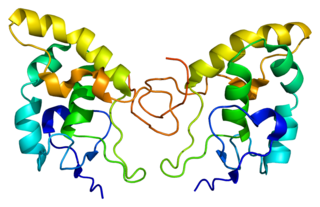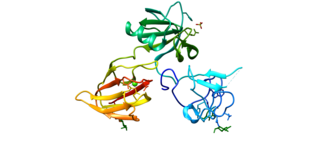Related Research Articles

Xenopus is a genus of highly aquatic frogs native to sub-Saharan Africa. Twenty species are currently described within it. The two best-known species of this genus are Xenopus laevis and Xenopus tropicalis, which are commonly studied as model organisms for developmental biology, cell biology, toxicology, neuroscience and for modelling human disease and birth defects.
The Wnt signaling pathways are a group of signal transduction pathways which begin with proteins that pass signals into a cell through cell surface receptors. The name Wnt is a portmanteau created from the names Wingless and Int-1. Wnt signaling pathways use either nearby cell-cell communication (paracrine) or same-cell communication (autocrine). They are highly evolutionarily conserved in animals, which means they are similar across animal species from fruit flies to humans.

Transcription factor 7-like 2 , also known as TCF7L2 or TCF4, is a protein acting as a transcription factor that, in humans, is encoded by the TCF7L2 gene. The TCF7L2 gene is located on chromosome 10q25.2–q25.3, contains 19 exons. As a member of the TCF family, TCF7L2 can form a bipartite transcription factor and influence several biological pathways, including the Wnt signalling pathway.

Glycogen synthase kinase-3 beta, (GSK-3 beta), is an enzyme that in humans is encoded by the GSK3B gene. In mice, the enzyme is encoded by the Gsk3b gene. Abnormal regulation and expression of GSK-3 beta is associated with an increased susceptibility towards bipolar disorder.

Frizzled-5(Fz-5) is a protein that in humans is encoded by the FZD5 gene.

Frizzled-8(Fz-8) is a protein that in humans is encoded by the FZD8 gene.

Dickkopf-related protein 1 is a protein that in humans is encoded by the DKK1 gene.

Low-density lipoprotein receptor-related protein 6 is a protein that in humans is encoded by the LRP6 gene. LRP6 is a key component of the LRP5/LRP6/Frizzled co-receptor group that is involved in canonical Wnt pathway.

Protein Wnt-3a is a protein that in humans is encoded by the WNT3A gene.

Dickkopf-related protein 3 is a protein in the Dickkopf family that in humans is encoded by the DKK3 gene.

Protein Wnt-7a is a protein that in humans is encoded by the WNT7A gene.

Wnt inhibitory factor 1 is a protein that in humans is encoded by the WIF1 gene. WIF1 is a lipid-binding protein that binds to Wnt proteins and prevents them from triggering signalling.

Protocadherin FAT1 is a protein that in humans is encoded by the FAT1 gene.

Proto-oncogene protein Wnt-3 is a protein that in humans is encoded by the WNT3 gene.

Dickkopf-related protein 2 is a protein in the Dickkopf family that in humans is encoded by the DKK2 gene.

Protein Wnt-11 is a protein that in humans is encoded by the WNT11 gene.

Protein Wnt-9a is a protein that in humans is encoded by the WNT9A gene.

Kremen protein 1 is a protein that in humans is encoded by the KREMEN1 gene. Kremen1 is conserved in chordates including amphioxus and most vertebrate species. The protein is a type I transmembrane receptor of ligands Dickkopf1, Dickkopf2, Dickkopf3, Dickkopf4, EpCAM and Rspondin1.

Wingless-type MMTV integration site family, member 2, also known as WNT2, is a human gene.

In molecular biology miR-203 is a short non-coding RNA molecule. MicroRNAs function to regulate the expression levels of other genes by several mechanisms, such as translational repression and Argonaute-catalyzed messenger RNA cleavage. miR-203 has been identified as a skin-specific microRNA, and it forms an expression gradient that defines the boundary between proliferative epidermal basal progenitors and terminally differentiating suprabasal cells. It has also been found upregulated in psoriasis and differentially expressed in some types of cancer.
References
- ↑ Jackstadt R, Hodder MC, Sansom OJ (2020-03-09). "WNT and β-Catenin in Cancer: Genes and Therapy". Annual Review of Cancer Biology. 4 (1): 177–196. doi: 10.1146/annurev-cancerbio-030419-033628 . ISSN 2472-3428.
- 1 2 3 4 Niehrs C (December 2006). "Function and biological roles of the Dickkopf family of Wnt modulators". Oncogene. 25 (57): 7469–81. doi:10.1038/sj.onc.1210054. PMID 17143291. S2CID 27082767.
- ↑ Glinka A, et al. (22 January 1998). "Dickkopf-1 is a Member of a New Family of Secreted Proteins and Functions in Head Induction". Nature . 391 (6665): 357–362. Bibcode:1998Natur.391..357G. doi:10.1038/34848. ISSN 0028-0836. OCLC 918993798. PMID 9450748. S2CID 29306691.
- ↑ Kagey MH, He X (December 2017). "Rationale for Targeting the Wnt Signalling Modulator Dickkopf-1 for Oncology". British Journal of Pharmacology . 174 (24): 4637–4650. doi:10.1111/bph.13894. ISSN 0007-1188. OCLC 1167996437. PMC 5727329 . PMID 28574171.
- 1 2 Baetta R, Banfi C (July 2019). "Dkk (Dickkopf) Proteins". Arteriosclerosis, Thrombosis, and Vascular Biology. 39 (7): 1330–1342. doi: 10.1161/ATVBAHA.119.312612 . PMID 31092014.
- ↑ Patel S, Barkell AM, Gupta D, Strong SL, Bruton S, Muskett FW, et al. (August 2018). "Structural and functional analysis of Dickkopf 4 (Dkk4): New insights into Dkk evolution and regulation of Wnt signaling by Dkk and Kremen proteins". The Journal of Biological Chemistry. 293 (31): 12149–12166. doi: 10.1074/jbc.RA118.002918 . PMC 6078440 . PMID 29925589.
- ↑ Shao YC, Wei Y, Liu JF, Xu XY (2017). "The role of Dickkopf family in cancers: from Bench to Bedside". American Journal of Cancer Research. 7 (9): 1754–1768. PMC 5622213 . PMID 28979801.